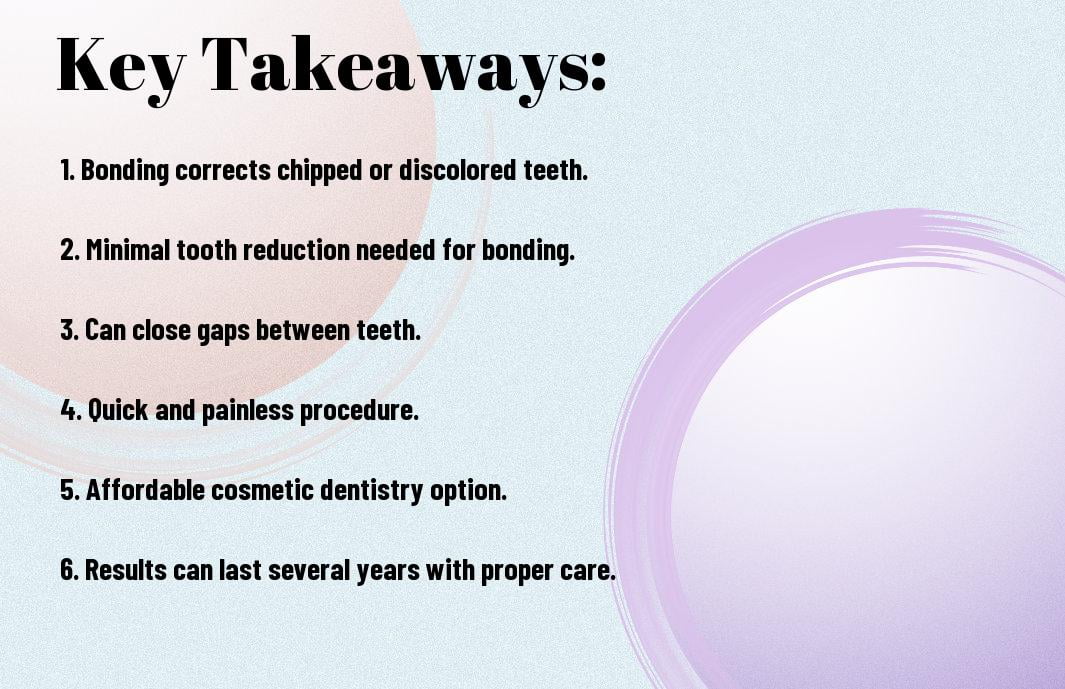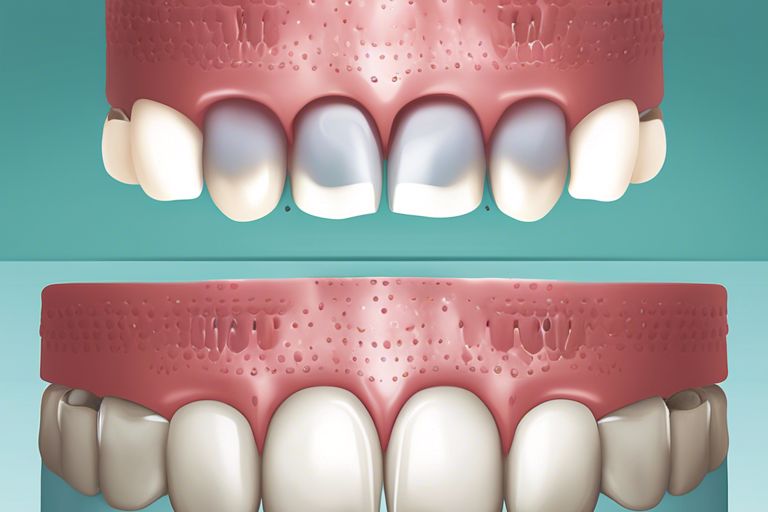Dentistry has witnessed remarkable advancements in cosmetic procedures, with dental bonding standing out as a versatile and popular technique. This minimally invasive procedure involves applying a tooth-colored resin material to the tooth surface, effectively concealing imperfections and enhancing aesthetics. From repairing chipped or cracked teeth to reshaping misaligned or uneven teeth, dental bonding offers a quick and cost-effective solution for various cosmetic concerns. Its ability to blend seamlessly with natural teeth, coupled with its durability and easy maintenance, makes it a sought-after choice for patients looking to achieve a flawless smile. However, it’s crucial to consult a skilled cosmetic dentist for precise application and long-lasting results.
Key Takeaways:
- Dental bonding is a versatile cosmetic dentistry procedure that can address a variety of issues such as chipped teeth, gaps between teeth, and discoloration.
- It is a cost-effective and minimally invasive way to improve the appearance of your smile without the need for extensive dental work.
- Dental bonding can be completed in a single visit to the dentist, making it a convenient option for those looking to enhance their smile quickly.
Fundamentals of Dental Bonding
Definition and Overview
To provide patients with natural-looking smiles, dentists often turn to the technique of dental bonding. Dental bonding involves the application of a tooth-colored resin material to teeth, which is then hardened with a special light. This process bonds the material to the tooth, allowing for various cosmetic improvements.
Dental Bonding Materials and Technologies
Technologies in dental bonding have advanced significantly, offering dentists a range of materials to choose from for optimal results. From composite resins to porcelain, the materials used in dental bonding are durable, strong, and aesthetically pleasing. The bonding process typically requires minimal tooth preparation, making it a popular choice for patients looking for quick and effective cosmetic enhancements.
Overview: Dental bonding materials like composite resin are versatile, allowing for repairs of chipped or cracked teeth, filling in gaps, reshaping teeth, and even covering stains. These materials are color-matched to the patient’s natural teeth, providing a seamless blend. While dental bonding is a relatively quick and painless procedure, it is important to note that the results are not as long-lasting as options like veneers or crowns.
Cosmetic Enhancements through Dental Bonding
Color Correction and Teeth Whitening
Any imperfections in tooth color can be effectively corrected through dental bonding, providing a seamless and natural-looking result. This procedure is especially useful for individuals looking to whiten their teeth but may have stains that do not respond well to traditional whitening methods. Dental bonding can be precisely matched to the shade of surrounding teeth, giving a consistent appearance.
Reshaping and Contouring of Teeth
Any minor imperfections in tooth shape or size can be easily addressed through dental bonding. This versatile technique allows for the reshaping and contouring of teeth to achieve a more harmonious and balanced smile. By using composite resin material, dentists can sculpt and reshape the teeth according to the patient’s desired specifications, improving the overall aesthetics of the smile.
Teeth reshaping and contouring through dental bonding can correct issues such as chipped or uneven teeth, creating a smooth and uniform appearance. The procedure is minimally invasive, preserving the natural tooth structure while enhancing its shape and symmetry. Patients can enjoy a more confident smile with immediate results that can dramatically transform their overall appearance.
Repair and Restoration Applications
Chipped or Cracked Teeth Repair
After a chip or crack in a tooth, dental bonding can be a saving grace. Using a tooth-colored resin material, a skilled cosmetic dentist can fill in the damaged area, restoring the tooth’s appearance and function. The bonding material is carefully applied, shaped, and hardened to blend seamlessly with the natural tooth, providing a durable and aesthetically pleasing solution.
Filling Tooth Gaps and Minor Alignment
With advancements in dental bonding techniques, filling tooth gaps and correcting minor misalignments is now more accessible than ever. This non-invasive procedure involves applying the bonding material to the targeted areas, reshaping the teeth to achieve better alignment and closing gaps effectively. Whether it’s a small gap between teeth or minor crowding issues, dental bonding can provide a quick and cost-effective solution.
A skilled cosmetic dentist can sculpt and polish the bonding material to blend seamlessly with the natural teeth, giving patients a more uniform and attractive smile. Unlike traditional orthodontic treatments, dental bonding offers an efficient and painless way to improve the overall appearance of the smile without the need for extensive procedures.
Advantages of Dental Bonding in Cosmetic Procedures
Comparing Bonding with Other Cosmetic Treatments
Many patients considering cosmetic dentistry procedures often weigh their options between dental bonding and other treatments like veneers or crowns. To help make an informed decision, let’s compare the advantages of dental bonding with other cosmetic treatments in the table below:
| Dental Bonding | Other Cosmetic Treatments |
| Non-invasive procedure | Require enamel removal |
| Single visit procedure | Multiple visits required |
| Affordable option | More expensive |
Cost-Effectiveness and Durability
Other than the advantages mentioned above, dental bonding is also renowned for its cost-effectiveness and durability compared to other cosmetic treatments. While veneers and crowns may offer long-lasting solutions, they can be more expensive and may require more extensive dental work. Dental bonding is a more affordable option that can last several years with proper care.
Understanding the advantages of dental bonding in cosmetic procedures, especially when compared to other treatments, can help patients make well-informed decisions. The non-invasive nature of bonding, along with its affordability and durability, make it a popular choice for enhancing the appearance of teeth.
Maintenance and Care of Bonded Teeth
Daily Oral Hygiene for Bonded Teeth
Unlike natural teeth, bonded teeth require specific care to maintain their appearance and durability. Oral hygiene is paramount in preserving the bonding material and preventing stains or discoloration. It is recommended to brush at least twice a day with a soft-bristled toothbrush and fluoride toothpaste. Flossing daily is also crucial to remove plaque buildup around the bonded areas.
Regular Dental Check-Ups and Bonding Longevity
Bonding is a durable cosmetic dentistry treatment, but it is not invincible. Regular dental check-ups are crucial to ensure the longevity of bonded teeth. Dentists can inspect the bonding material for any signs of wear, chipping, or staining. They can also professionally clean the bonded teeth, removing any stubborn plaque or tartar that could compromise the bond.
This proactive approach to regular dental check-ups not only helps maintain the aesthetic appeal of bonded teeth but also prevents potential issues that could lead to more significant dental problems in the future. By addressing any concerns early on, dentists can preserve the integrity of the bonding material and prolong the lifespan of the cosmetic enhancement.
To wrap up
On the whole, dental bonding is a versatile and effective tool in cosmetic dentistry for improving the appearance of a patient’s smile. From repairing chips and cracks to reshaping teeth and filling in gaps, dental bonding offers a minimally invasive solution with natural-looking results. This procedure can greatly enhance the overall aesthetics of a smile, providing patients with a quick and cost-effective way to achieve a more confident and beautiful smile. By consulting with a skilled cosmetic dentist, individuals can explore the many applications of dental bonding and determine if it is the right option for enhancing their smile.
FAQ
Q: What are the typical applications of dental bonding in cosmetic dentistry?
A: Dental bonding is commonly used in cosmetic dentistry for various procedures such as closing gaps between teeth, repairing chips or cracks, reshaping teeth, and covering up stains or discoloration.
Q: How long does dental bonding typically last?
A: With proper care and maintenance, dental bonding can last anywhere from 4 to 8 years. However, it may need to be touched up or replaced over time due to wear and tear.
Q: Is dental bonding a reversible procedure?
A: Yes, dental bonding is a reversible procedure. Unlike other cosmetic treatments like veneers, dental bonding is not permanent and can be removed or replaced if needed.







